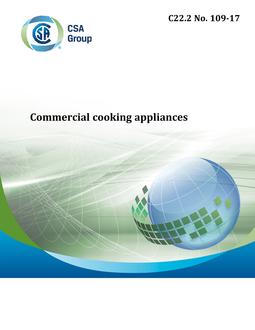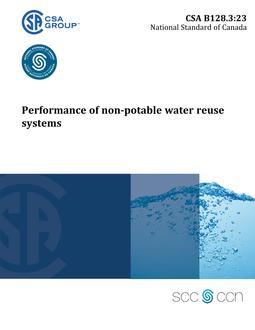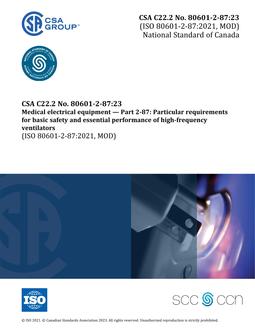
CSA C22.2 NO. 109-17
Preface
This is the third edition of CSA C22.2 No. 109, Commercial cooking appliances, issued by CSA Group under the Canadian Electrical Code, Part II. It supersedes the previous editions published in 1981 and 1957. This Standard also replaces the CSA Technical Information Letter (TIL) No. C-41, Interim Certification Requirements for Cord-Connected Commercial Electric Cooking Appliances. The major differences between this edition and the previous edition include updates to the flame tests and the addition of optional DC for the dielectric strength test. For general information on the Standards of the Canadian Electrical Code, Part II, see the Preface of CAN/CSA-C22.2 No. 0, General requirements – Canadian Electrical Code, Part II. This Standard is considered suitable for use for conformity assessment within the stated scope of the Standard.
Scope
1.1 This Standard applies to cord-connected and permanently connected electrically heated commercial cooking appliances for use on nominal system voltages of 600 V and less, that are intended to be used in accordance with CSA C22.1, Canadian Electrical Code, Part I. 1.2 This Standard applies to electric ranges, ovens, broilers, fry kettles, griddles, sandwich toasters, toasters, food warmers, coffee stoves, urns, hotplates, popcorn machines, liquid heaters, pressure cookers*, utensil warmers, and similar appliances. * Pressure vessels that may operate at pressures of 103 kPa and greater are subject to inspection by pressure vessel inspection authorities. 1.3 This Standard applies to food cooking and warming appliances for use in non-hazardous locations in commercial establishments. 1.4 This Standard does not apply to electrical equipment on coal- or gas-heated cooking equipment or to appliances employing high-frequency currents. 1.5 In this Standard, “shall” is used to express a requirement, i.e., a provision that the user is obliged to satisfy in order to comply with the Standard; “should” is used to express a recommendation or that which is advised but not required; and “may” is used to express an option or that which is permissible within the limits of the Standard. Notes accompanying clauses do not include requirements or alternative requirements; the purpose of a note accompanying a clause is to separate from the text explanatory or informative material. Notes to tables and figures are considered part of the table or figure and may be written as requirements. Annexes are designated normative (mandatory) or informative (non-mandatory) to define their application.
Product Details
- Edition:
- 3rd
- Published:
- 05/01/2017
- ISBN(s):
- 9781488307515
- Number of Pages:
- 55
- File Size:
- 1 file , 1.5 MB
- Product Code(s):
- 2425160, 2425160, 2425160


